-
 Long Kurtis Can Be Statement Pieces If You Know How to Style Them Properly! 10 Amazing Long Kurti Designs and How to Style Them in Different Ways (2020)
Long Kurtis Can Be Statement Pieces If You Know How to Style Them Properly! 10 Amazing Long Kurti Designs and How to Style Them in Different Ways (2020)
-
 Rock the Latest Lehenga Trends: 10 Stylish Saree Lehenga Recommendations for a Scintillating Look (2020)
Rock the Latest Lehenga Trends: 10 Stylish Saree Lehenga Recommendations for a Scintillating Look (2020)
-
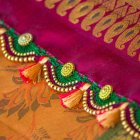 What is Saree Kuchu and How to Find the Perfect Saree Kuchu. 10 Must-Have Designs and Why You Should Use Them (2020)
What is Saree Kuchu and How to Find the Perfect Saree Kuchu. 10 Must-Have Designs and Why You Should Use Them (2020)
Understanding Kurti Styling
Commonly Used Kurti Fabrics
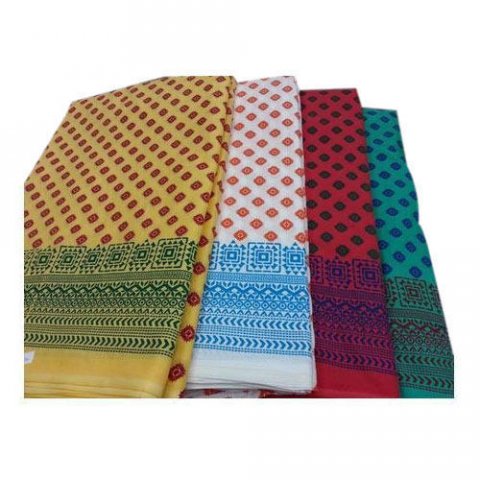
The only difference between a kurta and kurti is their length. A Kurti is often short, till the waist, the knee or calf length. If you’ve chosen your colour then the next best step is to choose the right fabric for your Kurti. This is mostly when you’re getting one made, and a careful consideration’s required for the kind of occasion you’d be wearing it for, the weather conditions and your body type.
For daily wear, Cotton is the most preferred fabric on account of its softness and its breathable texture. In addition, the fabric is easy to dye in different colours making it a versatile choice. Another popular choice is Silk, which is richer and more traditional comparatively. Heavy and thick fabrics like Mysore silk or Banarasi silk are used for wedding ensemble, while lighter materials like Tussar and Kosa are preferred for sarees and suits. Silk is usually good for winters. Known for its fall and softness, Georgette is typically used for designer wear. With subtle transparency, the fabric can be paired with a lining for a summer outfit, when selected for a Kurti. A similar, yet more refined fabric is Chiffon. Compared to its silky variant, the synthetic chiffon can be dyed into different colours and making it easy to customise.
Pairing Your Kurtis
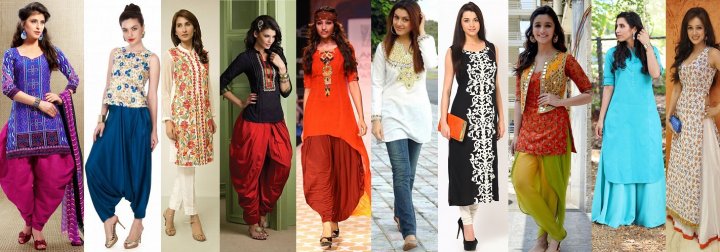
Kurtis can be paired with a variety of bottom wear. Pairing them with Palazzos is in these days for their smart, chic and fashionable appeal. One of the best ways of creating an illusion of being tall is to pair your kurti and bottom wear in one colour, as solid colours give an impression of vertical lines, which makes you look taller, that is if your height is under 5’4. The best colours, in this case, would be white, black, navy blue, purple or red.
Pairing your Kurti with a medium flared skirt that is ankle length can give a petite frame the tall illusion in addition to the chic styling. Smart and slim pants can also make one look taller with a straight kurti, while you can also benefit from wearing heels for more style and height.
Kurti Styles & Neck Designs
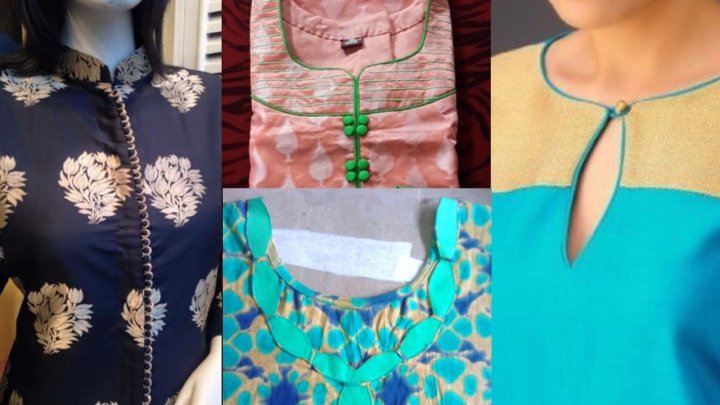
An ethnic necessity for every girl’s wardrobe, Kurtis are easy to wear and ideal for any occasion, with a wide range of choices for different body types. It is best to choose the right kind of neck style in a Kurti to do justice to your body structure. For women who have a balanced upper and lower body with a small waistline, long and slightly fitted kurtis would look good. For an apple shaped body structure, a diagonally striped or printed kurti, animal print or A-line kurti would do justice with a high neck. A deep V neck will take the attention away from the shoulders and accentuate the body curves. Cotton or khadi fabric would be appropriate for this body type.
For small bust and heavy hips, front slit kurtis with flare can conceal the plump parts and highlight the upper part of the body. For a rectangular body structure, frock style kurtis with a stretchable waistline would look good, while for women with a broad shoulder line, heavy torso and small hips, a jacket style or angarakha with knots or dori will take the attention away from the upper body. Kaftan kurtis with different patterns with dark colours will look appealing on circularly shaped bodies.
Your face structure can also make you look shorter or taller. To emphasise your facial structure, a long straight kurti, printed with smaller patterns and paired with leggings or cigarette pants will be perfect. You can accentuate it further by pairing the look with chandelier earrings or circular shaped ones and complete the ensemble with platform slippers. Vertical stripes, chevron prints and dual tones go well for a short face and heavy body built. They can be styled in a shirt style or long kurti.
For a petite frame, verticle hemline on a kurti, styled sleeveless or with capped sleeves and a boat neck, paired with parallel pants or embroidered salwars will look perfect. Bright coloured fabrics like turquoise, royal blue, bright peach or sea green with quarter sleeves with embroidered or lace cigarette pants or palazzos would gel for a tall body structure.
Types of Kurti Material You Can Buy Online
Hand Block Print Jaipuri Cotton Kurti Fabric

A speciality of Jaipur, this Cotton Fabric is handmade and all of 2.5 meters. It is a fine quality 100% cotton fabric with Hand block prints of Sanganer in Indigo Blue colour. The material is priced at Rs. 590. In terms of maintenance, it is the best hand-washed the first time, without soaking in water for long.
Kota Silk Kurti Fabric
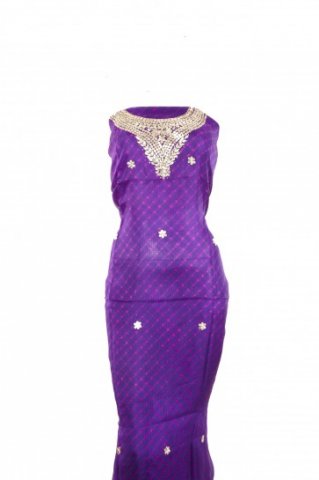
The Kota Silk Fabric is woven in a way that produces check patterns on the fabric, known Khats. They are very fine weaves and are light weight. The fabric is rubbed with onion juice and rice paste with a lot of care into the yarn making the fiber so strong that no extra varnishing is required. The Kota Silk fabric is comes with a body designed pattern in purple color in 2.55m and 50” in length. With a leheriya print, it’s styled with hand embroidery with gota, sequins and half fine silver zari work. It is priced at Rs. 1,775.
Pure Handwoven Pochampally Ikat Silk Cotton Fabric
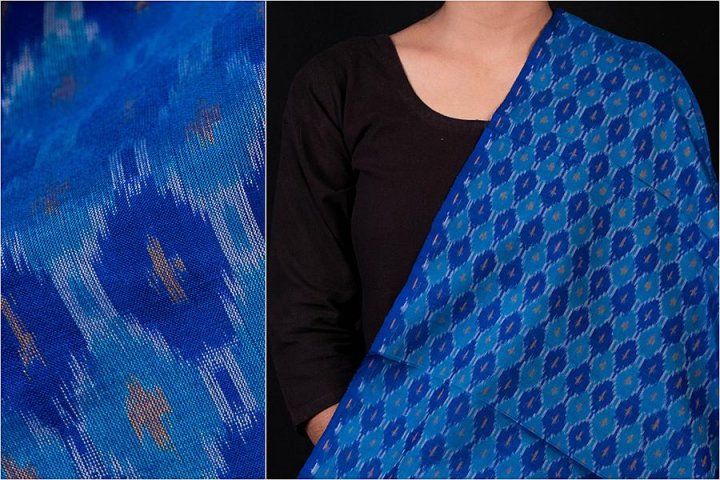
Woven by the traditional weavers of Telangana, the Pochampally Ikat Cotton Fabric presents a well-balanced fusion of the conventional and modern design. The Ikat pattern is usually designed, first by dying the thread and then using it in a loom to make formal stripe patterns with Ikat line designs. The fabric is 100% cotton silk with a 45” width and is priced at Rs. 1,120 per meter. It is best dry cleaned.
Dark Red And Golden Tree Pattern Chiffon Fabric
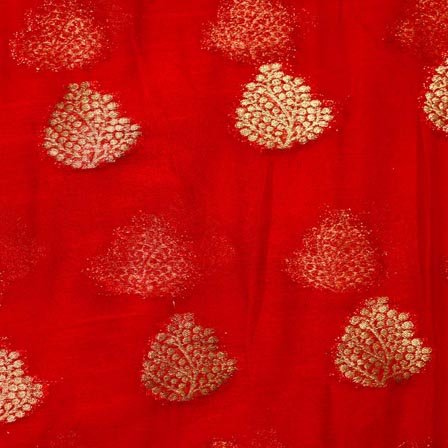
This Dark Red & Golden Tree Patterned Chiffon fabric is made out of Silk with a width of 44” and 40” in length. It weighs approx. 90gms per meter and is priced at Rs. 275 per meter. This material is a great option to make kurtis to wear for festive occasions.
Handloom Tussar Silk Fabric

Often called wild silk or tassar silk, Tussar Silk is a delicate and beautiful thread from a wide-winged, yellowish brown moth from the family of Emperor Moths. Their wings are exaggerated by circular marks that look like a mirror. Produced largely in India, tussar silk is valued highly for its natural gold color, and the dull gold texture of the fabric serves beautifully for embroideries and print motifs. The pure handloom tussar silk fabric is priced at Rs. 1,625 for a 2.5m kurti.
Self Dotted Printed Crepe Fabric
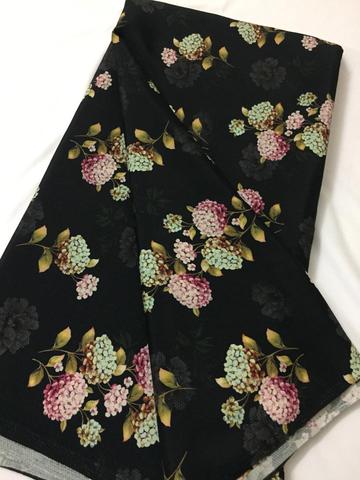
Crêpe or crepe is a synthetic, silk or wool fibre fabric with a unique, crisp & crimped look that gives it a heavily textured, woven or ribbed appeal. It is made using heavily twisted yarns, and gives its wearer a slim appearance, falling gracefully making it ideal for party wear. It is also preferred for daily wear, as the fabric requires little or no ironing and is very soft & comfortable. This Self-Dotted Printed Crepe Fabric is 2.5m in the colour black with a floral print and is priced at Rs. 950.
Two Tone Colour Polyester Self Jacquard Fabric
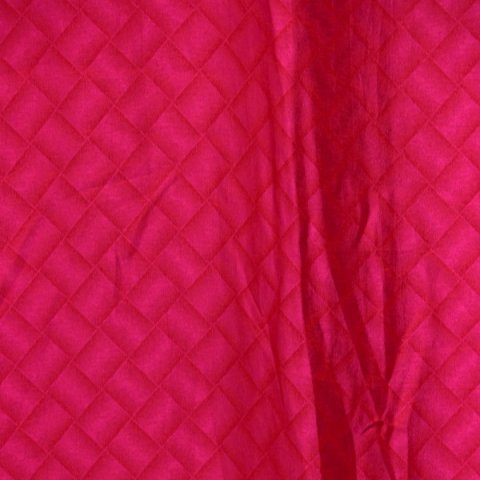
Jacquard Fabric comes with an elevated pattern that is laced into the fabric. Some of its most popular designs come in floral, geometric, paisley, animal or damask patterns, with varying draping style and durability, depending upon the fibres used. The 2 toned rani pink and red coloured polyester self-jacquard fabric is priced at Rs. 105 per meter at a width of 44” with an abstract design and is quite a flowy fabric.
Chanderi Fabric
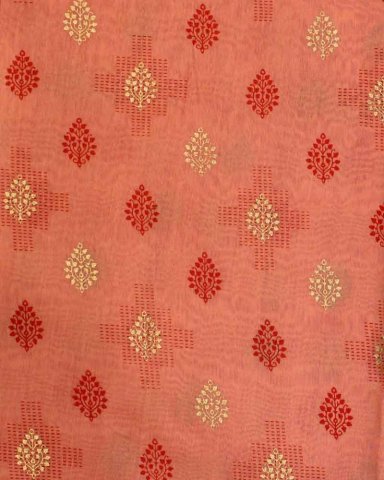
Chanderi is a conventional ethnic fabric that is highlighted with its lightweight and sheer texture and a fine glamorous appeal. It is created from the age-old cotton yarn by weaving in silk and golden zari that eventually results in its shimmering feel. Chanderi has its root in a small town by the same name, in Madhya Pradesh. With a gorgeous hand block design, this Coral Coloured Chanderi with leaves printed all over it is 42” in width and is priced at Rs. 106 per meter.
Linen

Widely used in the glamour world and made of fibres acquired from the linseed plant, Linen is known to be durable, well-made and very spongy. The fabric is versatile in its use and can be embroidered or printed on to create varying patterns and designs. The Linen Chambray Fabric is commonly used to make Kurtis. This fabric is weaved plain and is 58” in width, priced at Rs. 1,240 per meter.
Thread Embroidery on Royal Blue Georgette Fabric
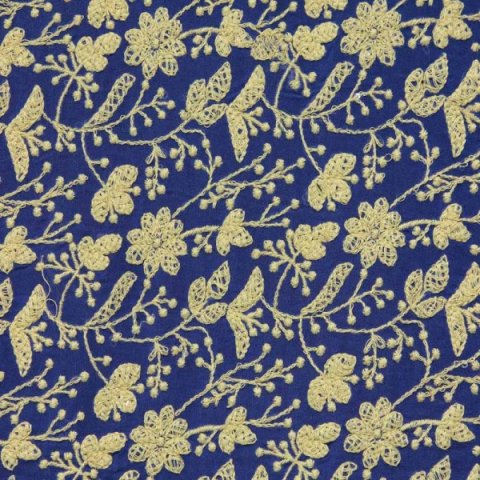
A lightweight and crinkled, sheer fabric, Georgette has a bouncy appeal, it is very porous, easy to dye and comes with a dull-rough feel. A georgette’s weaved with extremely twisted yarns of S and Z, either in pure or faux form in silk and rayon respectively. This Viscose Georgette Fabric with Lucknowi Thread Embroidery is 36” in width in royal blue color and is priced at Rs. 1,103 per meter.
Bonus Tip: How to Choose Kurti Fabrics Or Styles According to Your Body Structure

As one of the most popular choices for casual and party wear, Kurtis come in all kinds of styles like in long, short, or anarkali styles. Here are some quick tips to help you select the right fabric for a Kurti according to your body structure and style.
- Small Body Type – Georgette, crepe, soft cotton or soft silk, linen would look really good on a small built body, for their smooth clingy texture. A polyester or chiffon would just drop off from the body.
- Bulky Built– Fabrics like linen, soft cotton, georgette, soft silk or crepe would also work well with a chubby structure for their clinginess.
- Slim Structure - If you’re slim and want to add more volume to your body structure, then choose jute, mix cotton or heavy silk fabrics, you can also work with chiffon and polyester. A skinny body would look good in a long, flared Anarkali for casual wear, and otherwise, A-line cuts with a little flare.
- Pear Shape – If your bottom half of the body’s on the heavier side, then having a yoke that ends slightly below the bust, raising it a bit and accentuating it will call for a perfect balance between the upper and lower parts of the body.
- Styling the Small & Tall Parts of Your Body – If you’re short tall, then donning a straight kurti that is just 2-3” below your knees will lengthen your body frame, while wearing short kurtis with folded Patiala bottoms would give balance your height by giving it a shaped volume.
- Printed Fabrics - Prints are best selected small for larger frames, loud and more outgoing prints for small bodies, vertical stripes for brief structure and horizontal prints for tall bodies.
- Colours – Bright, bold and shine laden fabrics are good for skinny frames, while earthy, elegant, rustic and dark coloured fabrics are appropriate for a broader built.
- Slips & Misses – Avoid styling sleeveless, deep neck or open back kurti designs for a broad body type and layering, frills, glitter work or description in excess around the well-endowed parts of your body is a complete no!
-
 The Elegance of Cotton Sarees is Evergreen: 10 Different Types Of Cotton Saree You Must Have in Your Wardrobe (2020)
The Elegance of Cotton Sarees is Evergreen: 10 Different Types Of Cotton Saree You Must Have in Your Wardrobe (2020)
-
 Long Kurtis Can Be Statement Pieces If You Know How to Style Them Properly! 10 Amazing Long Kurti Designs and How to Style Them in Different Ways (2020)
Long Kurtis Can Be Statement Pieces If You Know How to Style Them Properly! 10 Amazing Long Kurti Designs and How to Style Them in Different Ways (2020)
-
 Rock the Latest Lehenga Trends: 10 Stylish Saree Lehenga Recommendations for a Scintillating Look (2020)
Rock the Latest Lehenga Trends: 10 Stylish Saree Lehenga Recommendations for a Scintillating Look (2020)
-
 What is Saree Kuchu and How to Find the Perfect Saree Kuchu. 10 Must-Have Designs and Why You Should Use Them (2020)
What is Saree Kuchu and How to Find the Perfect Saree Kuchu. 10 Must-Have Designs and Why You Should Use Them (2020)
-
 Nail That Glamorous Look with Stylish and Fashionable Kurtis. 10 Must-Have Kurti Designs at Myntra to Make Your Presence Felt (2020)
Nail That Glamorous Look with Stylish and Fashionable Kurtis. 10 Must-Have Kurti Designs at Myntra to Make Your Presence Felt (2020)
You Have a Vast Array of Choices in the Types of Fabrics to Choose from
A lot of factors need to be considered before choosing a fabric - occasion, weather, and body type being the top priorities. If you happen to be one of those women who doesn’t like to buy anything ready-made and prefer adding a personal touch to the things you wear, then buy a fabric according to your body structure and get a kurta stitched to give a look you want.

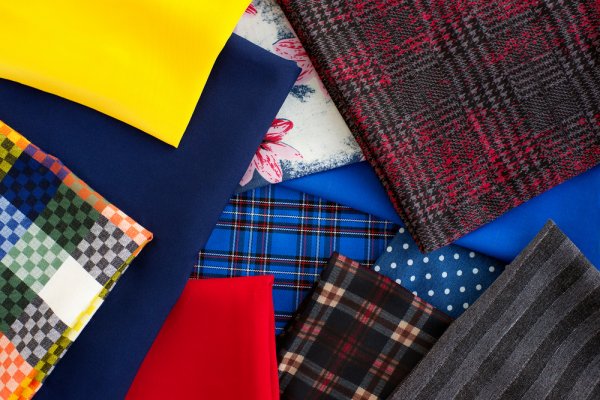
 Highlight the Best Facets of Your Incomparable Beauty: Discover the Best Face Highlighter Currently Available in India and Everything You Need to Know About Using Face Highlighters for Maximum Effect (2023)
Highlight the Best Facets of Your Incomparable Beauty: Discover the Best Face Highlighter Currently Available in India and Everything You Need to Know About Using Face Highlighters for Maximum Effect (2023)
 Forget the Blemishes and Get that Picture Perfect Flawless Radiance on Your Face: Check out the Best Foundations for Oily Skin Currently Available in India and Everything You Need to Know About Makeup Foundations (2023)
Forget the Blemishes and Get that Picture Perfect Flawless Radiance on Your Face: Check out the Best Foundations for Oily Skin Currently Available in India and Everything You Need to Know About Makeup Foundations (2023)
 Make Your Presence Felt Wherever You Go: Discover the Best Perfumes Under 2000 for Both Men and Women to Announce Your Arrival and Make Any Occasion Memorable (2023)
Make Your Presence Felt Wherever You Go: Discover the Best Perfumes Under 2000 for Both Men and Women to Announce Your Arrival and Make Any Occasion Memorable (2023)
 Protect Your Oily Skin from the Harmful Rays of the Sun: Discover the Best Gel Based Sunscreens for Oily Skin and Everything You Need to Know Before Buying One (2023)
Protect Your Oily Skin from the Harmful Rays of the Sun: Discover the Best Gel Based Sunscreens for Oily Skin and Everything You Need to Know Before Buying One (2023)
 Minor Blemishes and Wrinkles Affecting Your Confidence? Check out the Best BB Creams to Conceal Your Worries and Nourish Your Skin to Restore the Healthy, Radiant and Glowing Complexion Back Again (2023)
Minor Blemishes and Wrinkles Affecting Your Confidence? Check out the Best BB Creams to Conceal Your Worries and Nourish Your Skin to Restore the Healthy, Radiant and Glowing Complexion Back Again (2023)
